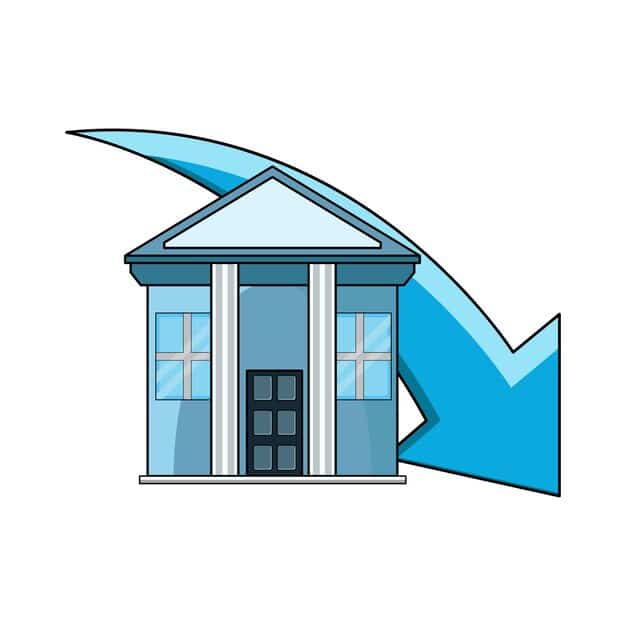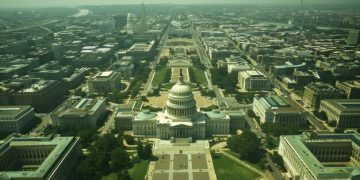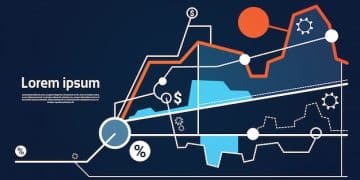Federal Reserve Interest Rate Adjustments: A Business Owner’s Guide

This guide deciphers how the Federal Reserve’s recent interest rate adjustments impact business operations and strategic planning, providing essential insights for owners navigating economic shifts and fostering resilience.
Understanding the Federal Reserve’s interest rate decisions can seem like navigating a complex economic maze, yet for business owners, grasping these adjustments is crucial. This guide on Decoding the Latest Federal Reserve Interest Rate Adjustments: A Business Owner’s Guide aims to demystify these impactful financial movements, offering a clear perspective on how they ripple through the economy and directly affect your enterprise.
The Federal Reserve’s Mandate and Monetary Policy Tools
The Federal Reserve, often simply called “the Fed,” operates as the central bank of the United States. Its primary role involves fostering a stable and growing economy, an objective pursued through what’s known as monetary policy. For business owners, understanding this foundational mandate is the first step in deciphering the Fed’s actions regarding interest rates.
The Fed’s dual mandate, established by Congress, focuses on achieving maximum employment and stable prices. While these goals appear straightforward, their implementation requires a delicate balance of various economic levers. Stable prices generally imply low and predictable inflation, protecting purchasing power for consumers and ensuring a predictable cost environment for businesses. Maximum employment, conversely, refers to a labor market where almost everyone who wants a job can find one, without triggering excessive inflationary pressures.
Key Monetary Policy Tools
To fulfill its mandate, the Federal Reserve employs several powerful tools. These are not static instruments but dynamic mechanisms continuously adjusted based on economic conditions and outlooks. Each tool has a unique way of influencing the money supply and credit conditions in the economy, ultimately impacting interest rates.
- The Federal Funds Rate: Perhaps the most talked-about tool, the federal funds rate is the target rate for overnight lending between banks. While the Fed does not directly control this rate, it influences it through open market operations, primarily buying and selling government securities. Changes in this target rate serve as a benchmark for other interest rates throughout the economy, from consumer loans to business lines of credit.
- The Discount Rate: This is the interest rate at which commercial banks can borrow money directly from the Federal Reserve. Although less frequently used than open market operations, changes in the discount rate signal the Fed’s stance on monetary policy. A higher rate might discourage borrowing, tightening credit conditions, while a lower rate could encourage it.
- Reserve Requirements: These are the portions of deposits that banks must hold in reserve rather than lend out. By adjusting these requirements, the Fed can influence the amount of money banks have available for lending. Historically, this tool was very impactful, but in modern times, it’s used less frequently for short-term adjustments, often set at zero for most deposit types.
- Interest on Reserve Balances (IORB): Introduced more prominently after the 2008 financial crisis, the Fed now pays interest on the reserves that commercial banks hold at the central bank. By adjusting this rate, the Fed can influence the incentive for banks to lend their excess reserves, directly impacting the effective federal funds rate and broader market rates.
The interplay of these tools shapes the overall financial environment, affecting everything from investment decisions to consumer spending. For business owners, understanding these mechanisms provides insight into the “why” behind interest rate changes and how to anticipate their impacts.
Ultimately, the Fed’s decisions are not made in a vacuum. They are the result of extensive analysis of economic data, forecasts, and global economic conditions, all aimed at steering the U.S. economy toward its dual mandate of maximum employment and price stability. These decisions, when announced, send immediate signals across financial markets and dictate the cost of capital for businesses across all sectors.
Understanding the Impact of Interest Rate Hikes on Business Operations
When the Federal Reserve increases interest rates, it initiates a ripple effect that touches nearly every aspect of business operations. For entrepreneurs and established companies alike, comprehending these impacts is vital for strategic planning and maintaining financial health. These adjustments are not merely theoretical; they translate into tangible changes in costs, market demand, and competitive landscapes.
Perhaps the most immediate and direct impact of higher interest rates is on the cost of borrowing. Businesses frequently rely on loans, lines of credit, and mortgages to fund daily operations, expansion projects, and inventory. As the federal funds rate rises, so do the interest rates that banks charge their customers. This means that new loans become more expensive, and for businesses with variable-rate debt, existing payments can also increase, directly affecting cash flow and profitability.
Increased Cost of Capital and Financing
Higher interest rates make all forms of debt more costly. This has several implications:
- New Borrowing: Whether it’s securing a loan for a new equipment purchase, expanding facilities, or simply replenishing working capital, the interest payments will be higher. This can diminish the profitability of new investments and make some projects unfeasible if the expected returns no longer outweigh the increased cost of capital.
- Existing Debt: Businesses with floating-rate loans or lines of credit will see their interest expenses rise. This can put a strain on cash flow, especially for companies operating on thin margins, forcing them to re-evaluate their budget allocations or seek alternative financing structures.
- Equity Financing: While not directly tied to interest rates, equity markets can also be influenced. When rising interest rates offer a safer, higher-return alternative (like government bonds), investors might demand higher returns from equity investments, potentially making it harder or more expensive for businesses to raise capital through stock issuance.
- Consumer Spending and Demand: Higher interest rates cool down the economy by making consumer borrowing more expensive. Mortgage rates rise, car loan rates increase, and credit card interest climbs. This can lead to decreased consumer spending, as individuals have less disposable income or are less willing to take on new debt. Businesses that rely heavily on consumer demand, such as retail, hospitality, and automotive, may experience a slowdown in sales and revenue. This softened demand can necessitate adjustments in production levels, inventory management, and marketing strategies.

Operational Adjustments and Strategic Planning
In response to rate hikes, businesses often need to make significant operational and strategic adjustments. This proactive approach can help mitigate negative impacts and identify new opportunities.
- Cost Optimization: A primary focus often shifts to reducing operating costs. This can involve renegotiating supplier contracts, optimizing supply chains, improving energy efficiency, or even implementing tighter controls on discretionary spending. Every dollar saved becomes more critical when the cost of borrowing increases.
- Inventory Management: Carrying excessive inventory becomes more expensive due to higher financing costs. Businesses might adopt just-in-time inventory strategies or reduce buffer stocks to minimize holding costs, though this must be balanced with the risk of supply chain disruptions.
- Pricing Strategies: Companies may need to re-evaluate their pricing models to absorb some of the increased costs or pass them on to consumers, provided market conditions allow. This requires a careful analysis of price elasticity of demand and competitive positioning.
- Investment Prioritization: Capital expenditure plans are often scrutinized more rigorously. Projects with long payback periods or lower anticipated returns may be deferred or canceled in favor of those with quick returns and high strategic value.
The cumulative effect of interest rate hikes can foster a more cautious economic climate, prompting businesses to be more discerning with their investments and expenditures. Preparing for these shifts by understanding their far-reaching implications is a cornerstone of resilient business management.
Assessing the Impact of Interest Rate Cuts: Opportunities and Risks
Just as interest rate hikes reverberate through the economy, so do cuts. When the Federal Reserve lowers interest rates, it typically signals a desire to stimulate economic growth, making borrowing cheaper and encouraging investment and spending. For business owners, these cuts present a distinct set of opportunities, but also some nuanced risks that demand careful consideration.
The most immediate and beneficial effect of an interest rate cut is the reduction in the cost of borrowing. This has a widespread positive impact:
Reduced Cost of Capital and Enhanced Investment
Lower interest rates significantly decrease the expense associated with debt, impacting various financial aspects for businesses:
- Cheaper Loans and Lines of Credit: New capital expenditures, such as purchasing equipment, expanding facilities, or investing in research and development, become more affordable. This reduced cost of capital can make previously marginal projects financially viable, potentially stimulating innovation and growth.
- Refinancing Opportunities: Businesses with existing high-interest loans, particularly those with variable rates or coming up for renewal, can often refinance at lower rates. This can lead to substantial savings on interest payments, freeing up cash flow that can be redirected towards other strategic priorities like marketing, product development, or talent acquisition.
- Increased Consumer Demand: Lower interest rates empower consumers by making mortgages, car loans, and consumer credit more accessible and affordable. This often translates into increased consumer spending, which can directly boost sales and revenue for businesses across various sectors, especially retail, housing, and automotive.
This environment of cheaper money is designed to encourage both businesses and consumers to spend and invest, thereby injecting vitality into the economy. Companies might find it easier to secure funding, leading to increased business activity and, potentially, job creation.

Potential Risks and Strategic Considerations
While often viewed positively, interest rate cuts are not without their complexities and potential downsides for businesses. Understanding these risks is crucial for making informed decisions.
- Sign of Economic Weakness: The Fed typically cuts rates when it perceives economic weakness, such as slowing growth, rising unemployment, or deflationary pressures. For businesses, this underlying economic backdrop can mean a challenging operating environment despite cheaper borrowing, with diminished consumer confidence or reduced overall demand.
- Inflationary Pressures: If rate cuts are too aggressive or persist for too long in a recovering economy, they can eventually lead to inflationary pressures. While moderate inflation can be healthy, runaway inflation erodes purchasing power, increases the cost of raw materials and labor, and makes financial planning difficult for businesses.
- Market Overheating: Prolonged periods of very low interest rates can sometimes contribute to asset bubbles, where prices of assets like stocks or real estate become inflated beyond their fundamental value. If these bubbles burst, it can lead to economic instability, posing risks to businesses, particularly those heavily invested in these sectors or dependent on a robust financial market.
For businesses, the strategic approach to interest rate cuts should involve more than just exploiting cheaper capital. It requires a holistic assessment of the broader economic climate, competitor actions, and long-term market trends. While opportunities to expand or upgrade might be tempting, a thorough risk assessment remains paramount. Smart businesses will leverage the lower cost of capital to fortify their balance sheets, invest in efficiency improvements, and diversify their revenue streams, rather than simply accumulating more debt. It’s about harnessing the tailwind without ignoring potential headwind on the horizon.
Navigating Economic Downturns: Strategies for Business Resilience
Economic downturns are an inevitable part of the business cycle, often characterized by reduced consumer spending, tighter credit, and increased uncertainty. Interest rate adjustments, whether hikes to curb inflation or cuts to stimulate growth, play a significant role in these periods. For business owners, the ability to build resilience and adapt quickly is not just advantageous—it’s essential for survival and long-term success.
One of the most critical aspects of navigating a downturn is disciplined financial management. This involves more than just cutting costs; it’s about optimizing capital structure, maintaining liquidity, and protecting profit margins when revenues may be constrained.
Financial Fortification and Cash Flow Management
Strengthening financial foundations is paramount during uncertain economic times:
- Prioritize Cash Flow: Cash is king, especially in a downturn. Focus intensely on managing receivables, optimizing inventory levels to prevent capital tie-up, and negotiating favorable payment terms with suppliers. Businesses should create robust cash flow forecasts, stress-testing them against various adverse scenarios to identify potential shortfalls early.
- Reduce Discretionary Spending: Conduct a thorough review of all expenses, identifying areas where spending can be reduced or eliminated without impacting core operations. This might include delaying non-essential capital expenditures, scaling back marketing efforts, or negotiating better rates with vendors.
- Manage Debt Prudently: Re-evaluate existing debt obligations. If interest rates are falling, consider refinancing high-interest loans. If rates are rising, explore fixed-rate options or strategies to reduce overall debt exposure. Maintaining a healthy debt-to-equity ratio provides more flexibility in challenging times.
Beyond financial strategies, operational agility and strategic foresight also play a crucial role. Businesses that can quickly adapt their products, services, and operational models are better positioned to weather the storm.
Operational Agility and Strategic Adaptations
Adapting operations and strategy to meet changing market conditions is vital:
- Diversify Revenue Streams: Relying on a single product, service, or customer segment can be risky. Explore opportunities to diversify offerings, target new markets, or develop complementary services that can perform well even in a downturn.
- Strengthen Customer Relationships: During uncertainty, customer loyalty becomes even more important. Focus on retaining existing clients by providing exceptional service, value, and support. Loyal customers can provide a stable revenue base when new customer acquisition becomes more challenging.
- Invest in Efficiency and Technology: Downturns can be an opportune time to invest in technologies and processes that enhance efficiency, automate tasks, and reduce long-term operating costs. This not only improves resilience but also positions the business for stronger growth when the economy recovers.
- Employee Engagement and Flexibility: Maintain open communication with employees, fostering a sense of shared purpose. Consider flexible work arrangements or upskilling programs to retain talent and adapt to changing operational needs.
- Contingency Planning: Develop multiple contingency plans for various scenarios, including severe drops in demand or prolonged economic stagnation. This proactive approach allows for faster, more informed decision-making when challenges arise.
By implementing these strategies, business owners can transform potential threats into opportunities for strengthening their enterprise, emerging from economic turbulence more robust and competitive than before. Resilience is not passive survival; it is an active, strategic process of adaptation and continuous improvement.
Decoding the Fed’s Language: Signals and Projections
For business owners, understanding the Federal Reserve’s actions isn’t just about reacting to immediate interest rate changes; it’s also about anticipating future moves. The Fed communicates frequently through various channels, and learning to decode its “language”—the statements, speeches, and economic projections—provides invaluable insights into the likely direction of monetary policy. This foresight allows businesses to plan proactively, rather than reactively.
The Federal Open Market Committee (FOMC) statements are the primary source of real-time information. Released eight times a year, these statements typically announce interest rate decisions and provide a brief rationale. However, the true value lies in the nuances of their language.
Key Elements of Fed Communication
- Forward Guidance: The Fed often provides “forward guidance,” which are explicit statements about the future path of monetary policy. This guidance helps manage market expectations. Phrases like “will remain highly accommodative” or “gradual increases” signal the Fed’s intent. Businesses should pay close attention to any changes in this guidance, as it reflects the Fed’s evolving outlook on the economy.
- Economic Conditions and Outlook: FOMC statements and speeches frequently comment on the state of the economy, including assessments of inflation, employment, and economic growth. These observations indicate whether the Fed believes its dual mandate is being met or if further action is needed. For example, if the Fed emphasizes concerns about persistent inflation, it signals a hawkish stance, potentially leading to rate hikes. Conversely, if it highlights slowing growth or rising unemployment, it suggests a more dovish approach, hinting at potential rate cuts.
- “Dot Plot” Projections: Four times a year, the Fed releases its Summary of Economic Projections (SEP), which includes the famous “dot plot.” This chart anonymously shows each FOMC member’s projection for the federal funds rate at the end of the current year and for the next few years. While not an official forecast, the median of these dots provides a strong indication of where policymakers believe rates are headed. Business owners can use this to gauge the consensus view within the Fed and adjust their long-term financial planning accordingly.
Beyond formal statements, speeches by the Chair of the Federal Reserve and other governors often offer deeper insights into the central bank’s thinking. These speeches, often delivered at economic conferences, elaborate on specific economic trends, challenges, and the rationale behind recent policy decisions, providing context that formal statements may lack.
Reading Between the Lines: Tapering and Quantitative Easing
Beyond explicit rate changes, the Fed also uses tools like quantitative easing (QE) and quantitative tightening (QT), also known as “tapering.” QE involves the Fed buying large quantities of government bonds and other securities to inject liquidity into the financial system, putting downward pressure on long-term interest rates. QT is the reverse, reducing the Fed’s balance sheet and effectively tightening monetary policy.
When the Fed announces it will begin “tapering” its asset purchases, it signals a move towards less accommodative monetary policy, often preceding interest rate hikes. Conversely, the introduction of new QE programs signals an intent to stimulate the economy, typically during periods of economic distress.
For business owners, regularly monitoring these communications is an exercise in strategic anticipation. Understanding the Fed’s current sentiment and its likely future course allows for better financial forecasting, investment planning, and risk management. It transforms what might seem like obscure financial jargon into actionable intelligence that directly impacts your bottom line.
Practical Strategies for Business Owners Amidst Rate Changes
Navigating the complex landscape of Federal Reserve interest rate adjustments requires more than just a theoretical understanding; it demands practical, actionable strategies. For business owners, translating economic forecasts into tangible operational decisions can ensure resilience and open new pathways for growth, regardless of whether rates are rising or falling.
One of the most immediate and impactful areas to focus on is debt management. The cost of borrowing directly impacts profitability and expansion potential, making strategic debt optimization a cornerstone of financial health.
Optimizing Debt and Cash Management
- Review and Restructure Debt: Regularly assess your existing loans, lines of credit, and mortgages. If rates are dropping, explore opportunities to refinance high-interest debt to lower monthly payments, freeing up cash flow. If rates are rising, consider converting variable-rate loans to fixed-rate options to lock in predictable payments and protect against future increases.
- Build Cash Reserves: In periods of uncertainty, or when interest rates are high making borrowing expensive, having a robust cash reserve is invaluable. This liquidity provides a buffer against unforeseen expenses, allows for opportunistic investments, and reduces reliance on external financing.
- Manage Working Capital Efficiently: Optimize your working capital by streamlining accounts receivable and payable processes. Encourage faster customer payments and negotiate extended payment terms with suppliers where possible. Efficient inventory management also plays a crucial role in freeing up capital.
Beyond managing existing finances, proactive engagement with your banking partners and a keen eye on operational efficiencies can provide further advantages.
Strategic Operational and Market Adjustments
- Foster Strong Banking Relationships: A solid relationship with your financial institution can be a significant asset. Your bank can offer tailored advice, flexible financing solutions, and insights into market conditions. Regular communication ensures they understand your business needs and can offer timely support.
- Implement Technology for Efficiency: Consider investing in technologies that improve operational efficiency, automate tasks, and reduce costs in the long run. This can include cloud-based accounting software, supply chain optimization tools, or customer relationship management (CRM) systems. Such investments can yield significant returns, especially when economic pressures mount.
- Diversify Funding Sources: Do not rely solely on traditional bank loans. Explore alternative financing options such as venture capital, angel investors, government grants, crowdfunding, or asset-based lending, depending on your business type and growth stage. Diversifying funding sources provides flexibility and reduces dependence on any single channel.
- Assess Pricing and Demand Sensitivity: Understand how changes in interest rates and broader economic conditions impact your customers’ purchasing power and willingness to spend. This might necessitate adjusting your pricing strategies, offering different product tiers, or focusing on value propositions that resonate in a changing economic climate.
- Monitor Key Economic Indicators: Stay informed not only about the Fed’s actions but also broader economic indicators like inflation rates, unemployment figures, and consumer confidence. This wider context provides a more complete picture of the economic environment in which your business operates, enabling more informed decision-making.
Ultimately, successful navigation through Federal Reserve interest rate adjustments boils down to a combination of financial prudence, strategic foresight, and operational agility. Businesses that prioritize these areas are better equipped to withstand economic headwinds and capitalize on new opportunities, ensuring long-term stability and growth.
Future Outlook and Preparing for Continued Volatility
The economic landscape is dynamic, characterized by continuous shifts, and the actions of the Federal Reserve are a primary driver of this change. For business owners, recognizing that interest rate adjustments are part of an ongoing cycle, not isolated events, is key to developing a robust, forward-looking strategy. The future outlook suggests a period of continued volatility, which demands proactive preparation and a commitment to perpetual adaptation.
One crucial aspect of future preparation involves understanding the underlying forces that influence the Fed’s decisions. Global economic trends, geopolitical events, supply chain stability, and technological advancements all play a role in shaping the economic environment and, consequently, monetary policy.
Anticipating Future Trends and Shocks
- Global Economic Interconnectedness: No economy thrives in isolation. Global inflation, international trade disputes, or economic slowdowns in major trading partners can influence the U.S. economy and the Fed’s policy stance. Monitoring these international dynamics is essential for businesses with global supply chains or international markets.
- Technological Disruption: Rapid technological advancements can create new industries, disrupt old ones, and influence productivity and labor markets, all of which eventually impact economic growth and inflation. Businesses that fail to adapt to these technological shifts risk being left behind, regardless of interest rate environments.
- Geopolitical Risks: Geopolitical tensions, conflicts, or major policy shifts in other nations can introduce significant uncertainty into global markets, affect commodity prices, and disrupt supply chains. Such events can prompt immediate reactions from central banks to stabilize their economies, often through monetary policy adjustments.
Given these influences, future interest rate movements may be less predictable than in stable periods, requiring businesses to build greater flexibility into their financial and operational models.
Building for Long-Term Resilience and Adaptability
Successful businesses in a volatile future will be those that integrate resilience into their core:
- Scenario Planning: Move beyond single-point forecasts. Develop multiple scenarios for future economic conditions—optimistic, pessimistic, and moderate—and outline how your business would respond to each. This prepares you for a range of possibilities rather than being caught off guard.
- Flexible Supply Chains: Diversify your supplier base and consider localizing parts of your supply chain to reduce vulnerability to international disruptions and geopolitical risks. Building redundancies can cost more in the short term but pay dividends during crises.
- Talent Development and Retention: Investing in your workforce through training and creating a flexible, supportive work environment can significantly enhance your business’s ability to adapt. A skilled and loyal team is a critical asset when navigating challenging economic waters.
- Continuous Innovation: Even in tighter economic times, allocate resources to research and development and product innovation. Developing new products or services that meet evolving customer needs can open new revenue streams and ensure relevance, making your business less susceptible to economic downturns.
- Strategic Partnerships: Forge strong relationships with partners, customers, and even competitors where advantageous. These networks can provide support, insights, and opportunities for collaboration during uncertain times.
The journey through the economy’s ebb and flow, influenced heavily by Federal Reserve actions, is continuous. By adopting a mindset of perpetual readiness and strategic adaptability, business owners can not only weather future storms but also emerge stronger, more innovative, and better positioned for sustained success.
| Key Point | Brief Description |
|---|---|
| 📊 Cost of Capital | Rate changes directly impact loan costs, affecting business investment and debt servicing. |
| 💰 Consumer Spending | Fed rates influence consumer borrowing and spending, affecting demand for goods and services. |
| 🛡️ Business Resilience | Adaptable financial and operational strategies are crucial to navigate rate volatility. |
| 📈 Market Signals | Understanding Fed communications and economic projections helps anticipate future policy. |
Frequently Asked Questions About Fed Rate Adjustments
▼
The Federal Reserve’s main objective, known as its dual mandate, is to foster maximum employment and maintain price stability, which implies keeping inflation low and predictable. Interest rate adjustments are a key tool to achieve these goals, influencing economic activity, borrowing costs, and consumer spending.
▼
For small businesses, interest rate hikes can significantly increase the cost of borrowing for operational expenses, expansion, or inventory. This may reduce profitability, make new investments less attractive, and impact cash flow, requiring careful financial planning and cost management to navigate effectively.
▼
Interest rate cuts lower the cost of borrowing, making it cheaper for businesses to finance expansion, invest in new equipment, or refinance existing debt. They can also stimulate consumer spending, boosting demand for products and services, thereby creating opportunities for growth and increased revenue.
▼
Anticipating Fed changes involves monitoring FOMC statements, the “dot plot” projections from central bank officials, and speeches by Federal Reserve leaders. Paying attention to economic indicators like inflation, employment data, and GDP growth also provides clues, as these inform the Fed’s decision-making process.
▼
Businesses can build resilience by prioritizing cash flow, optimizing debt structures (e.g., locking in fixed rates), maintaining strong relationships with financial institutions, and diversifying financing sources. Investing in operational efficiency and continuously adapting business models to market conditions are also crucial strategies.
Conclusion
In essence, mastering the nuances of Federal Reserve interest rate adjustments is not merely an academic exercise for business owners; it’s a critical component of strategic leadership. These monetary policy decisions ripple through every corner of the economy, directly influencing the cost of capital, consumer demand, and the overall business environment. By diligently decoding the Fed’s signals, understanding the intricate impacts of both hikes and cuts, and implementing proactive strategies for financial health and operational agility, business owners can transform potential economic headwinds into opportunities for growth and sustained resilience. The preparedness fostered by this understanding ensures that your business remains not just afloat, but adaptable and competitive, through every turn of the economic cycle.





